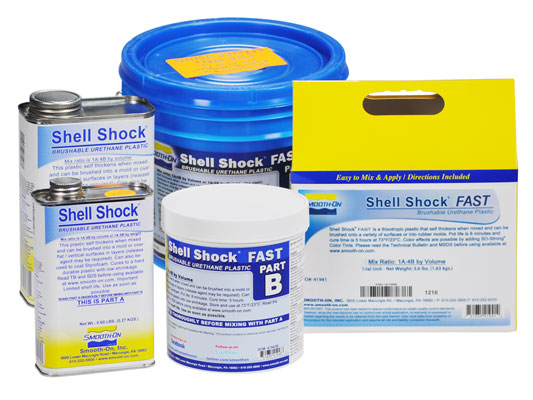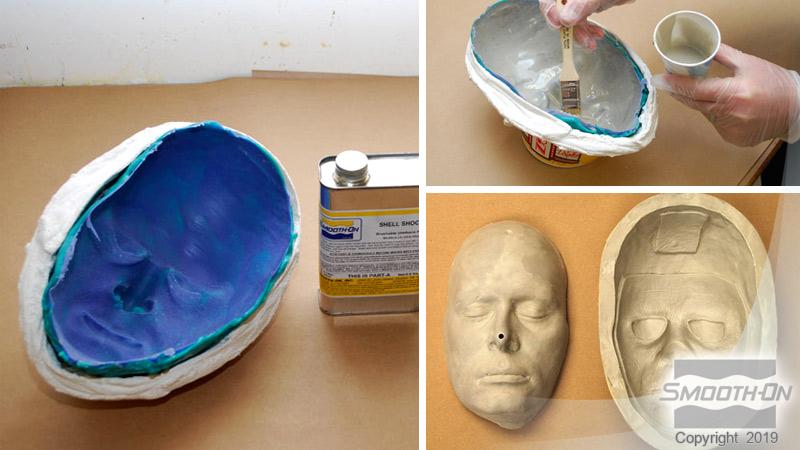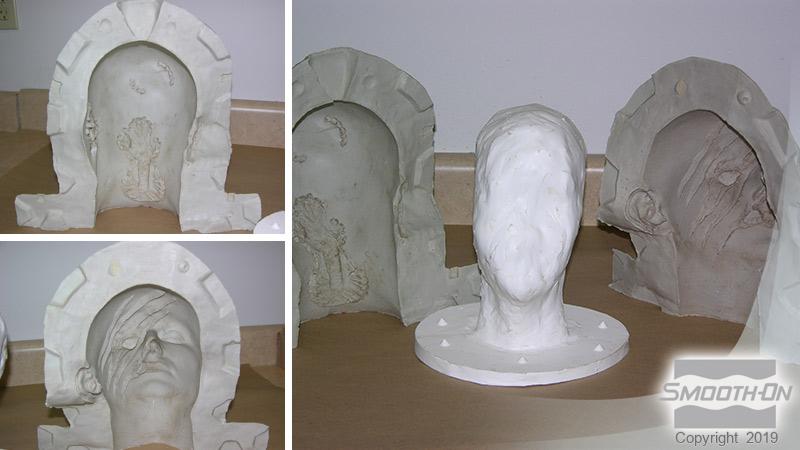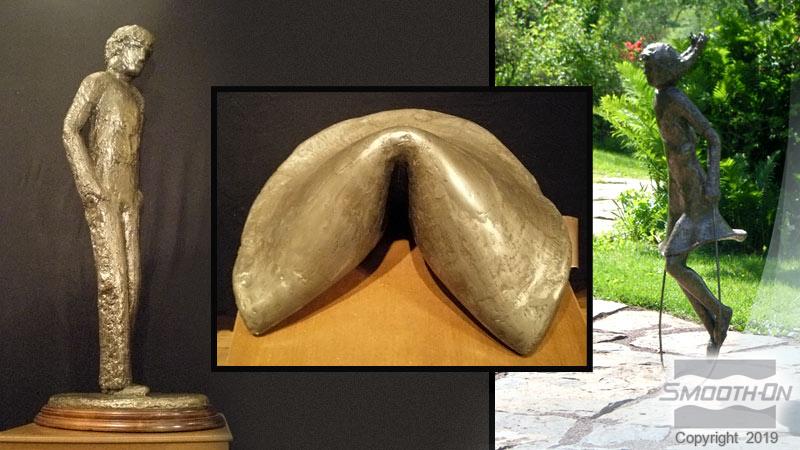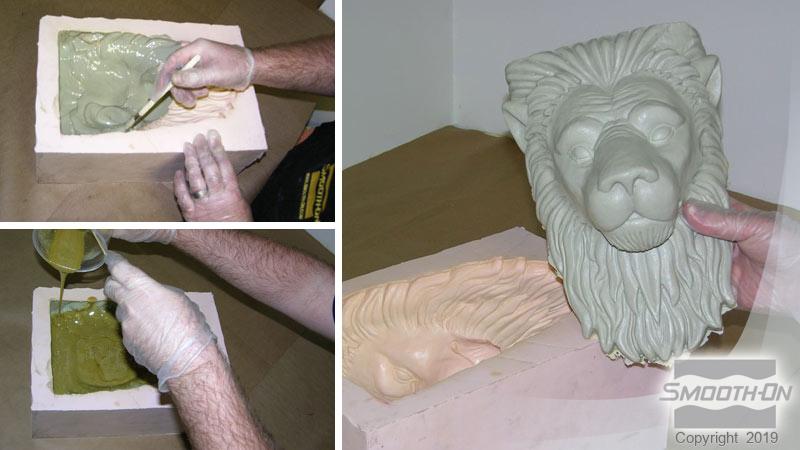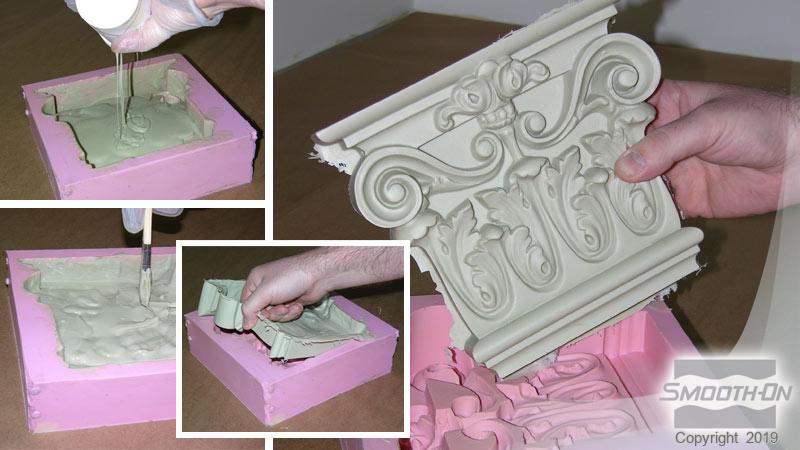Shell Shock™ FAST
Shell Shock™ FAST is a thixotropic plastic that self thickens when mixed and can be brushed onto a variety of surfaces or into rubber molds. When Parts A and B are mixed in proper proportion (1A:4B by volume or 1A:5B by weight), material cures at room temperature with virtually no shrinkage to a hard, durable plastic that exhibits good compressive and flexural strength. Fully cured castings are rigid and can be sanded, primed and painted. Color effects are possible by adding SO-Strong™ Color Tints.
Features
Shell Shock™ plastics are ideal for making fast, lightweight rigid molds for creating silicone appliances and effects (use as a replacement for ‘stone molds’). You can also brush a “gel coat” into a rubber mold and back it up with rigid foam, creating a highly detailed lightweight casting. These products can also be brushed onto styrofoam (polystyrol) as an impact resistant coating that can be sanded, primed and painted (minimum 3 coats recommended). Shell Shock™ plastics can also be used to make rigid support shells for brush on rubber molds.
Instructions
Preparation - All liquid urethanes are moisture sensitive and will absorb atmospheric moisture. Water based clays are not recommended. Mixing tools and containers should be clean and made of metal or plastic. Materials should be stored and used in a warm environment (72° F / 22° C). This material has a limited shelf life and should be used as soon as possible. Mixing should be done in a well-ventilated area. Wear safety glasses, long sleeves and rubber gloves to minimize contamination risk. Because no two applications are quite the same, a small test application to determine suitability for your project is recommended if performance of this material is in question.
Applying A Release Agent - A release agent is necessary to facilitate demolding when applying into or over most surfaces. Use Mann’s Ease Release™ 200 which will release both urethanes and silicones. A liberal coat of release agent should be applied onto all surfaces that will contact the plastic. IMPORTANT: To ensure thorough coverage, apply release and brush with a soft brush over all surfaces. Follow with a light mist coating and let the release agent dry for 30 minutes.
When casting silicone into a mold made with Shell Shock™, a release agent is not necessary, but applying a release agent will make demolding easier and will prolong the life of the mold.
IMPORTANT: Shelf life of product is reduced after opening. Remaining product should be used as soon as possible. Immediately replacing the lids on both containers after dispensing product will help prolong the shelf life of the unused product. XTEND-IT™ Dry Gas Blanket (available from Smooth-On) will significantly prolong the shelf life of unused liquid urethane products.
Mixing - PRE-MIX PART-B BEFORE YOU BEGIN. After pre-mixing Part-B, dispense required amounts of Parts A and B into mixing container and mix thoroughly for about 1 minute. Stir deliberately, making sure that you scrape the sides and bottom of the mixing container several times. Material will begin to thicken almost immediately.
Applying - Using a clean brush for each layer, apply layers of plastic until desired thickness is attained (3/8” or 1 cm is recommended for minimum physical strength). Make sure your first coat is a thin layer applied with a ‘stippling’ motion to minimize air bubbles.
Curing - Important: Use this product with at least room size ventilation or in proximity to a forced outlet air vent and do not inhale/breath fumes. Fumes, which may be visible with a significant mass concentration, will quickly dissipate with adequate ventilation. Castings with significant mass may be hot to the touch and irritate skin immediately following cure. Let casting cool to room temperature before handling.
Demold time of the finished casting depends on mass and mold configuration. Low mass or thin-walled castings will take longer to cure than castings with higher mass concentration.
If making rotational or hollow castings, backfilling with a rigid foam (Foam-iT!™ 5 or other) will provide lightweight reinforcement. Foam backfilling is recommended if castings will be subjected to temperatures above 85°F / 30°C.
Post Curing - Although not necessary, post curing will increase physical properties and material performance. After curing at room temperature, expose material in the mold to 150°F/65°C for 2 hours. Let cool to room temperature before use.
Performance - After building enough layers, cured material is rigid, hard and durable. Material will resist moisture, moderate heat, solvents, dilute acids and can be machined; primed/painted or bonded to other surfaces (any release agent must be removed). Before sanding or machining, let Shell Shock™ FAST cure for at least 4 hours at 73°F/23°C. If machining castings, wear dust mask or other apparatus to prevent inhalation of residual particles. Castings can be displayed outdoors after priming and painting. Unpainted castings will darken after being exposed to UV light. Because no two applications are the same, a small test application to determine suitability is recommended if performance of this material is in question.
Related Categories: Urethane Resins
Related Series: Shell Shock™ – Brushable Liquid Polyurethane Plastic
How-To Articles
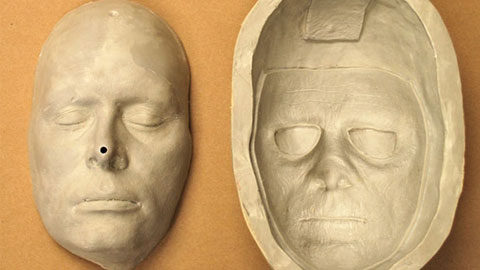
How To Create a Urethane Resin Makeup Prosthetic Mold
This sequence outlines the construction of a mold to cast silicone f/x makeup appliances.
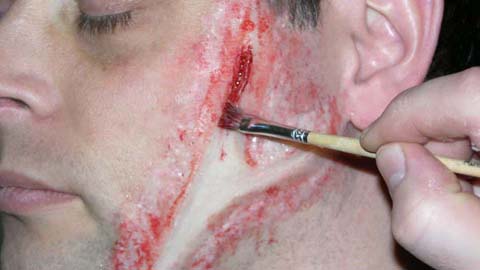
How To Make a Silicone Wound Using a Plate Mold
This step-by-step guide will illustrate how to make a flat resin plate mold that you can cast platinum silicone into.
